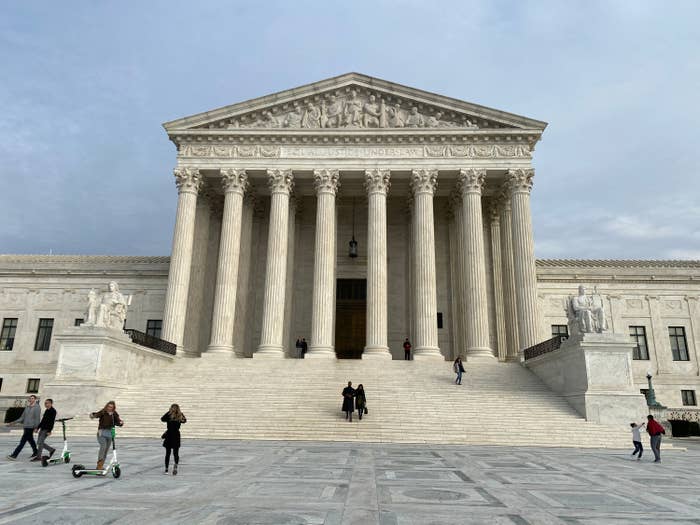
The Supreme Court said on Monday it won’t hear a case from gun rights activists challenging a federal ban on bump stocks, which were prohibited after being used in a 2017 Las Vegas shooting where 58 people were killed.
The high court’s order will keep the devices, which allow semiautomatic weapons to fire rapidly like machine guns, banned for the time being. But with other bump stock cases winding through appeals, courts could still reverse the ban in the future.
In its most concrete terms, the lawsuit filed by a Pennsylvania man and gun rights advocacy groups is about whether a bump-fire stock turns a semiautomatic firearm, which is legal, into a prohibited machine gun.
The Bureau of Alcohol, Tobacco, Firearms and Explosives, known as ATF, issued a regulation in 2018 that reversed years of policy to declare the devices were illegal under long-standing law and could be seized by law enforcement in response to the Vegas shooting.
Although the court decided not to hear the case, it raised an abstract, yet also closely watched, dispute about the separation of powers between courts and the executive branch.
Challengers asked the court to reconsider a legal doctrine known as Chevron deference — created by the 1984 Supreme Court ruling in Chevron U.S.A., Inc. v. Natural Resources Defense Council — which prevents courts from overruling certain federal agency regulations. Lower courts cited Chevron deference as the reason to let the ban on bump stocks stand.
Striking down Chevron deference, a goal of conservative groups like the Heritage Foundation, which say federal agencies rules overstep their bounds, could give judges renewed powers to interfere in decisions made by the executive branch.

Justice Neil Gorsuch wrote a four-page statement on Monday saying he disagreed with lower courts applying Chevron deference in the case — in part because both parties, including the ATF, said it didn't apply.
"The court placed an uninvited thumb on the scale in favor of the government. That was mistaken," Gorsuch wrote.
Nonetheless, Gorsuch agreed that the Supreme Court should pass on the case for now while lower courts further consider the bump stock ban in this and other cases.
Back to the more tangible issue — a bump-fire stock is an attachment that cradles the butt end of a semiautomatic rifle. When a person pulls the trigger, the fire’s recoil makes the gun jump backward into the bump stock, which resets the firing mechanism. If the shooter maintains forward pressure by leaning into it, the rifle gets pushed forward after each shot, causing the trigger to “bump” into the shooter’s finger, firing another round. This process repeats rapidly. The back-and-forth motion can discharge upward of 400 rounds a minute — or more than eight per second, far more frequently than if a shooter had to pull the trigger each time.
During the Obama and Trump administrations, ATF found the devices weren’t covered by a ban on machine guns under the National Firearms Act and Gun Control Act. But after the October 2017 massacre in Las Vegas, where a gunman fired on a crowd using bump stocks attached to rifles, President Donald Trump and others urged a ban. Officials issued a final rule in December 2018, reversing course on their previous stance, saying, “these devices convert an otherwise semiautomatic firearm into a machine gun.” The regulation required existing devices to be surrendered to law enforcement or destroyed.
Along with several legal challenges, which continue to percolate in federal courts, a complaint was filed in December 2018 by the Firearms Policy Coalition, Firearms Policy Foundation, Madison Society Foundation, and Damien Guedes — a Pennsylvania man who bought a bump stock in 2014. The case at the Supreme Court, consolidated with other lawsuits, is Guedes v. ATF.
The plaintiffs allege that ATF violated the Administrative Procedure Act by cutting short public comments. Arguing the rule “inherently smacks of agency abuse,” they also argued bump stock owners would be denied Fifth Amendment rights under the Takings Clause, which says property cannot be seized without financial compensation.
The Justice Department countered by insisting it was simply making a fair reading of the law and that previous decisions to allow bump stocks had been “erroneous.”
A district court and, later, an appeals court in Washington, DC, sided with the Justice Department and against gun activists by upholding the ban — but not the way either side had asked for.
The courts found that Chevron deference had to be applied, meaning courts must abstain from overriding the agency’s bump stock regulation. Chevron deference says, broadly speaking, that if a law is ambiguous, such as the National Firearms Act, then an agency can create a reasonable regulation based on the law and courts cannot interfere. (A similar doctrine, known as Auer deference, says courts must defer to reasonable agency interpretations of their own regulations.)
The gun rights activist, having lost in lower courts, asked the Supreme Court to hear their appeal and rule Chevron deference must not apply. They said the Supreme Court should instead apply the rule of lenity, which dictates that when a criminal law is ambiguous, the defendant charged with a crime should receive the lightest punishment.
The plaintiffs are also asking the Supreme Court to consider whether agencies like ATF can waive their right to Chevron deference, and, because the lower court’s “decision so grossly interprets Chevron deference,” it raises “the question whether Chevron should be overruled.”
The Justice Department — even though it beat the gun activists in lower courts — also disagreed with the reasoning of the lower courts that leaned on Chevron. Still, federal lawyers told the Supreme Court it should ignore the deference matter entirely in a December filing, writing, “the Chevron questions that petitioners seek to present should not be addressed in a case in which no party urges the application of Chevron.” DOJ attorneys went on to say the agency had simply made “the best interpretation of the statute — wholly apart from the question of deference.”
Gorsuch's statement Monday pointed out that if courts defer to agencies reflexively, the meaning of laws can shift with political winds.
"The agency used to tell everyone that bump stocks don’t qualify as 'machine guns.' Now it says the opposite," he wrote. "The law hasn’t changed, only an agency’s interpretation of it. And these days it sometimes seems agencies change their statutory interpretations almost as often as elections change administrations."
Since the ban on bump stocks punishes offenders with criminal sanctions, Gorsuch added, Chevron deference, "has no role to play when liberty is at stake."
"The errors apparent in this preliminary ruling might yet be corrected before final judgment," he said, sending the case back to lower courts.
Conservatives have become particularly critical in recent years of Chevron and Auer deference, which they contend grant agencies undeserved authority. Several conservative Supreme Court justices have questioned it in past decisions, including Gorsuch, who wrote in 2016 when he served on the Court of Appeals for the 10th Circuit, “under Chevron, the problem remains that courts are not fulfilling their duty to interpret the law and declare invalid agency actions,” adding that Chevron deference “seems to have added prodigious new powers to an already titanic administrative state."
